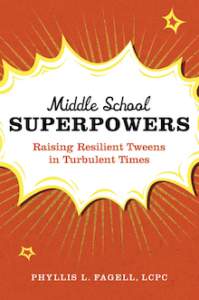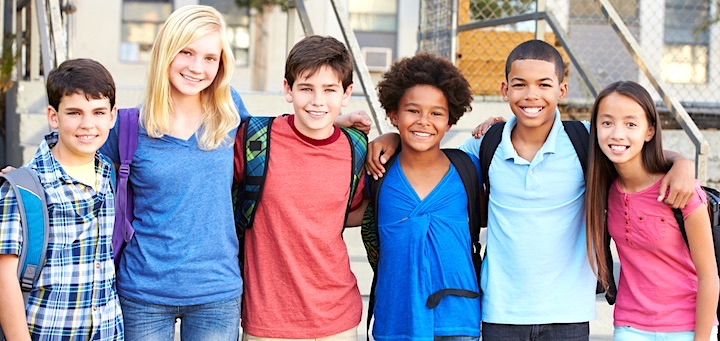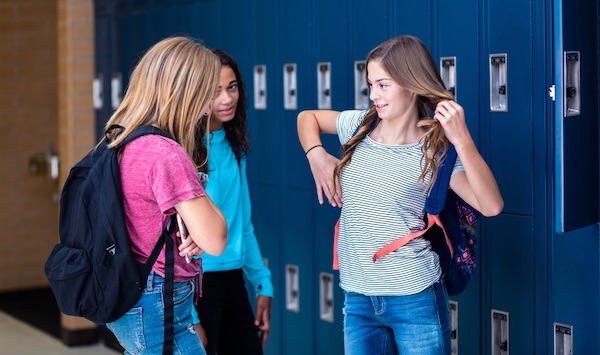8 Ways to Help Tweens Take Academic Risks
Students in the middle grades think in polarities and will go to great lengths to avoid embarrassment, writes author and school counselor Phyllis Fagell. But with the right supports, they can become risk-takers who learn more.
By Phyllis Fagell

A quick glance at the clock confirmed that Jonah was supposed to be in Spanish class. “That sounds frustrating,” I replied. “Did something happen that upset you?”
“I’m a total idiot – that’s what happened,” Jonah said. He had just stormed out of class, he shared, because kids laughed at him for mixing up the Spanish words for embarazoso (embarrassing) and embarazada (pregnant). At the time, he was too worked up to appreciate the irony.
Even when things are going well, middle schoolers can be mercilessly self-critical, easily discouraged, and acutely sensitive to how they’re perceived. That can make it hard for them to recover from a mistake, let alone continue to go out on a limb.
I wrote my new book Middle School Superpowers, Raising Resilient Tweens in Turbulent Times to help students in this age group get out of their own way. Here are eight things educators can do to help tweens and early teens overcome self-doubt and take academic and social risks.
1. Empower students to set interpersonal ground rules.
Never underestimate the toll that social distractions and disappointments can take on a student’s willingness to take academic risks. Hold regular meetings to nip interpersonal problems early and establish a safe classroom culture.
Better yet, let students lead these conversations. For instance, a fifth-grade boy and a fifth-grade girl who had been teased about their crushes asked to plan a special lesson with me about “crush etiquette.”
They came up with a bunch of scenarios, such as harassing someone to reveal their crush, pressuring someone to reveal a friend’s crush, teasing someone for having a crush, and asking someone repeatedly whether they like them after they said they don’t. The two then asked the class to determine as a group whether each one represented a “do” or a “don’t.” (All of the above were “don’ts.”)
2. Bolster their social skills to boost their willingness to participate.
Even tweens who have strong social skills can find it daunting to enter a crowded cafeteria or raise their hand in class, but it’s exponentially harder for kids with social skills deficits. And in recent years, I’ve observed more students struggling to incorporate simple behaviors such as giving one another credit, waiting for an opening before speaking, avoiding snap judgments, and setting phones aside while interacting.
To boost students’ willingness to speak up in class, carve out time to actively practice interpersonal skills. For instance, spend a few minutes at the start of class facilitating an icebreaker activity or providing a conversation starter – such as a question about a favorite food or activity – so that everyone can practice asking and answering questions.
3. Help them reframe negative or ambiguous interactions with teachers.
Tweens are acutely aware of what child psychologist David Elkind called the “imaginary audience,” or the belief that you’re always being scrutinized, and that makes it easy to feel judged and embarrassed.
For instance, if a teacher scolds an entire class for being too chatty, a student might take it personally. While it’s easy for tweens to interpret a positive or neutral statement as negative, teachers can help them think more expansively. For instance, when a girl insisted that her first-period teacher addressed her with a sharp tone because she “hated” her, I asked her to come up with other, less offensive possibilities. (I first explained that she didn’t have to believe the reasons – the idea was to boost her cognitive flexibility.)
The girl paused for a moment, then said, “I guess it’s possible she was tired or in a bad mood. Maybe she was stressed because she overslept or had a flat tire on the way to school.” When students can at least entertain the possibility that a negative interaction wasn’t personal, they’re more likely to actively engage in class.
4. Make it safe to be authentic and admit weaknesses.
Kids who are overly concerned about being humiliated, evaluated or rejected may dread or avoid situations that carry social risk and feel motivated to conceal their personal flaws. Explain that that’s counterproductive. Research shows that when kids can be authentic, they’re less socially impaired and their relationships improve.
As researchers reported in the Journal of Personality and Social Psychology, we tend to perceive our own vulnerability more negatively than other people’s. Plus, confessing a so-called weakness is likely to be viewed as courageous by others, a phenomenon known as “the beautiful mess effect.” To encourage this kind of authenticity, teachers can model vulnerability and be open about their own weaknesses and mistakes.
5. Give students real responsibility (and a sense of control).
When children assume that outcomes are the result of their own behavior, it’s protective. It also builds their confidence and willingness to attempt a difficult task.
Researcher Julian Rotter asked participants in his studies to choose between two statements: “Becoming a success is a matter of hard work; luck has little or nothing to do with it” and “Getting a good job depends mainly on being in the right place at the right time.” He found that university students who chose the first statement (suggesting an internal locus of control) were less likely to present with depression symptoms, which in turn can have a negative effect on their ability to bounce back after an embarrassing or disappointing incident at school.
Teachers can initiate a dialogue with students about the difference between something within their control and something beyond it. For instance, a middle schooler can control how hard they study and whether they go in before school for extra help, but they can’t control the grade the teacher gives them.
Educators can also embolden students to take risks by entrusting them with real responsibility, whether they ask them to sit on a teacher interview panel, spearhead a school-wide service project, mentor younger students or greet them at the door in the morning, lead a class lesson, or organize a dance, assembly or game night for classmates.
6. Help them reframe their own individual differences.
All middle schoolers are insecure, but it can be especially hard for neurodiverse students to take risks at school. To build their courage, help them see their challenges through a different lens. Share examples of individuals who succeeded because of – rather than in spite of – their differences.
For instance, IKEA founder Ingvar Kamporad credits dyslexia with giving him the idea to innovate by using visuals to help people put furniture together, and the famous clothing designer Tommy Hilfiger thinks dyslexia helps him see things differently than other designers.
When a student shies away from risks because of their specific learning difference, I’ll ask them to come up with two strengths that come with that so-called weakness. For instance, researchers at the University of Cambridge found that people diagnosed with dyslexia actually have “enhanced” abilities in areas such as discovery, invention and creativity. They suggest that people with dyslexia have traits that were selected during human evolution because they confer an advantage, and as such, we shouldn’t define dyslexia as a disorder.
7. Help kids recognize and challenge their own faulty thinking.
Middle schoolers think they wouldn’t lie to themselves, but they do, whether they catastrophize, forecast the future, mind read, think in all-or-nothing terms, or discount the positive. If a teacher changes their seat because they’re being disruptive, for instance, they might conclude that the relationship is irreparably damaged. Or if they bomb a math test, they might think, “I’m terrible at math and there’s no point in trying.”
This kind of defeatist, unproductive thinking not only worsens their suffering but also makes it less likely that they’ll take risks that carry the potential for embarrassment. To challenge their negativity, hang a list of cognitive distortions on a classroom wall, and when you hear a student using an extreme word such as “never” or “always,” ask them to look at the list and try to identify their thinking error.
Once they understand how they’re “lying to themselves,” you can teach them to talk back to their inner critic. For instance, if they’re telling themselves, “I’m not smart enough for the advanced math class,” they can ask themselves questions such as “How useful is it to get caught up thinking that way? What evidence do I have that I’d be unable to handle the class? What’s the best-case scenario? What resources or help would I need to cope if it turns out that the class is in fact difficult?”
Read our MiddleWeb review
of Phyllis Fagell’s latest book:
Middle School Superpowers:
Raising Resilient Tweens in Turbulent Times.
8. Be mindful about language.
The words adults use can have a big impact on students’ willingness to do things such as lead a class discussion or share a poem they wrote with their classmates. Middle school is when kids may start to exhibit perfectionist tendencies that hold them back from taking that kind of risk.
To interrupt perfectionism, it helps to be intentional about language. For instance, researchers found that referring to a child’s efforts as “rough-draft thinking” can encourage a hesitant or risk-averse student to ask questions and enter discussions despite a fear of “failure.”
Teachers can encourage students to be mindful about the language they use themselves, too. For instance, kids can combat defeatist thinking by coming up with a mantra like, “I’m going to be as patient with myself as I am with my friends.” In one study, researchers found that when nine- to 13-year-old students took five minutes before a test and “silently spoke words of encouragement to themselves that were focused on effort,” their math scores improved.
Nurturing risk-takers
Middle schoolers think in polarities and will go to great lengths to avoid embarrassment at school. But when educators understand tweens’ distinct developmental needs and teach them how to experiment, fail and recover, they’ll continue to take academic risks.

Also see her MiddleWeb article 10 Ways We Can Help Tweens Feel Included. You can learn more about Phyllis and her work at her website.

































Phyllis, the way you offer concrete examples of basic positive psychology tenets is really helpful in translating proven theory into practice. You incorporate elements of growth mindset, cognitive coaching, and disputation practice seamlessly into understandable, easily implementable strategies to use with kids. Thanks for the authentic, specific applications that help clarify an array of choices for teachers can use to promote student self-efficacy.